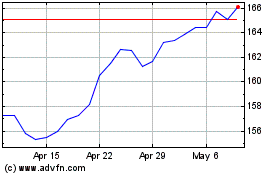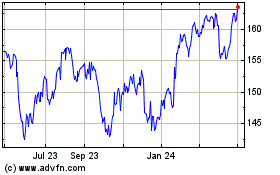By Sharon Terlep
Procter & Gamble Co., seeking to prove that the
consumer-products giant that invented Ivory soap, Crest toothpaste
and disposable Pampers diapers hasn't lost its touch, has spent
nearly a decade working on a new line of products it hopes will
fill American homes.
P&G has developed a way to make laundry detergent, hand soap
and shampoo without a key ingredient: water.
Executives said the new dry soaps and cleaners, which come in
the form of small, fabric-like "swatches" that foam when users add
water during washing or cleaning, will reduce substantially water
used in production and be lighter and smaller to package and ship.
That could make it easier for P&G to sell them online,
bypassing retailers such as Walmart Inc. and Amazon.com Inc.
P&G said it doesn't yet know how much mass appeal the
products, which are expected to appeal to younger and
environmentally conscious consumers, will have. The company will
face the challenge of convincing consumers that the soaps and
cleaners are as good as something they would buy in a bottle,
analysts said.
P&G launched Monday a website selling limited quantities of
dry hand soap and laundry detergent, with six more products going
on sale in early June, also in limited quantities. They will range
in cost from 60 swatches of face wash for $19 to 30 swatches of
laundry detergent for $29.
Initially called EC30, P&G executives are still deciding
whether the products, should they go on sale for the mass market,
would have their own brand or bear well-known P&G names such as
Mr. Clean, Tide and Olay.
The rollout comes as P&G is riding a sales rebound, and more
than a year after activist investor Nelson Peltz joined the
company's board following a costly proxy fight.
Mr. Peltz has pushed P&G to more aggressively pursue
breakthroughs, which P&G Chief Executive David Taylor has said
the company is already doing.
Despite a solid U.S. economy, household-goods makers in the last
couple of years have experienced stagnating sales amid increased
competition, a consumer shift toward smaller brands and higher
materials costs.
P&G late last year said it would increase prices for several
products to address rising costs and reverse a trend of price
cutting, and other consumer-goods companies have followed suit.
Lee Ellen Drechsler, the dry-soap project's research and
development director at P&G, in 2011 began tinkering with the
idea of condensing cleaning chemicals into minuscule fibers that
dissolve when wet -- similar, she said, to cotton candy.
"We realized we could make a suite full of products that
performed as well or even better than those made with water," said
Ms. Drechsler, a 26-year P&G veteran.
P&G earlier this year decided the lineup was ready for
broader public consumption after testing the idea with board
members and some consumers through a crowdfunding website last
summer, in which people paid to help fund the project in exchange
for receiving early versions of the product.
Mr. Peltz made P&G's lack of recent blockbusters a central
issue of the 2017 proxy fight, saying that the 182-year-old company
that pioneered laundry detergent had become too mired in
bureaucracy to innovate. Its last billion-dollar business, Tide
Pods, was released in 2012.
P&G executives said the company's pipeline hadn't dried up
but acknowledged a need to develop new products faster and with
different goals in mind. P&G said it needed to look more
broadly at factors such as packaging, emotional connection and
rival offerings, not simply quality and efficacy as measured in
labs and by consumer feedback.
P&G shares are up roughly 45% in the past year as the
company cut costs, reorganized internally and experienced stronger
sales. In the decade prior, P&G shares gained just 8% while the
S&P 500 nearly doubled.
Using the old metrics, "you would have thought P&G was
growing in every category," Kathy Fish, the company's R&D
chief, recently told investors. "It was very humbling to find we
weren't as good as we thought we were."
The dry soaps represent a test case for P&G. Typically an
R&D team must work with other departments to manufacture,
package and market a new offering. In the case of EC30, Ms.
Drechsler's team includes people from each unit. The EC30 lab has
its own production line.
Instead of waiting until the project was fully baked to begin
selling to consumers, P&G used crowdfunding site Indiegogo.com
to generate interest and real-life product testers. P&G quickly
sold out on the site.
The swatches meet the safety standards of any P&G product in
the market, Ms. Drechsler said. P&G had to repackage its Tide
Pods several years ago after young children and elderly people
ingested the colorful, concentrated detergent packets.
The company missed a few deadlines and had to ship the products,
which come in boxes made of bamboo to eliminate plastic waste, in
plastic bags. P&G is close to eliminating the bags, but still
needs them to keep the products dry throughout the shipping and
delivery process, said Tom Dierking, the project's design director.
It is also is working on packaging that better keeps swatches dry,
since several are used in or near water.
The amount of water used in the production of soaps and
detergents represents a fraction of water consumed in the process
of using the products. To substantially reduce water use, P&G
would need to work on ways to cut down on how much water is needed
to, for instance, do a load of laundry, said Deepak Rajagopal, an
assistant professor at the Institute of the Environment and
Sustainability at the University of California, Los Angeles.
"Most of the impact happens on the consumer side," he said.
P&G's Mr. Dierking said high-quality cleaning and
personal-care products require less washing time. "The most we can
do is use the best ingredients possible to minimize water usage,"
he said.
Elizabeth Bain, a 46-year-old lawyer from Oregon, got both the
personal-care and household cleaning lines through the Indiegogo
campaign. She has used the toilet cleaner, which mostly dissolved
overnight, and then she used the remnants to scrub the bowl clean
with a brush.
She said she might be more likely to buy the items if they came
with a new, non-P&G name. "I'm less concerned with brand
names," she said. "And more concerned with efficiency."
Write to Sharon Terlep at sharon.terlep@wsj.com
(END) Dow Jones Newswires
April 22, 2019 11:37 ET (15:37 GMT)
Copyright (c) 2019 Dow Jones & Company, Inc.
Procter and Gamble (NYSE:PG)
Historical Stock Chart
From Mar 2024 to Apr 2024

Procter and Gamble (NYSE:PG)
Historical Stock Chart
From Apr 2023 to Apr 2024
